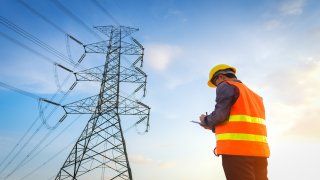The U.S. Must Close the Long-Distance Power Transmission Gap with China
The gap in long-distance transmission technologies between the United States and China raises significant national security implications
In October 2023, the U.S. Department of Energy (DOE) released a triennial report that revealed, among other things, that the U.S. transmission system, as currently built, is already at or near capacity across several states, including Texas and Alaska. A transmission system at capacity restricts growth in at least two crucial ways: more electricity cannot easily be added to the grid, and the grid cannot be expanded to include renewables. Consumption growth centers—like cities—and renewable generation—like wind farms—are often separated by long distances, so any potential grid expansion must first consider long-distance transmission projects.
A 2023 RAND study found that China, as part of its efforts to create a Global Energy Interconnection (GEI), has taken a significant lead on the United States in developing the technologies required to move power long distances. China has emerged as the world’s leader in the transmission technologies needed to connect power grids across regions and even countries. China ranks first in the three of four metrics used to determine national standing on these technology groups. It has also published more academic papers and filed more patents on some of these technologies, such as transmission at ultra-high voltage (UHV) levels and submarine cables than the United States has. And while China has already developed thirty-four UHV lines on its territory, the United States has none.
The gap in long-distance transmission technologies between the United States and China raises significant national security implications, the first of which is China leveraging its growing commercial and civilian penetration of foreign power grids for espionage or military purposes. China’s growing technological and technical prowess in transmission technologies has enabled Chinese companies to grow their global market share while exporting Chinese technologies and standards abroad, often at the expense of established competitors. As Chinese products and standards flood the market, China could benefit from lock-in effects and become the provider of choice for super grids globally, increasing dependency on China for key clean energy supply chains. Therefore, similar to other energy transition technologies such as solar or batteries for electric vehicles, China’s technological lead may allow it to set market dominance in long-distance transmission.
The U.S. government recently announced a commitment of $1.3 billion to address its transmission needs. The United States should go a few steps further by working to reduce the technology gap with China on long-distance transmission. This would both address its current domestic transmission needs while also mitigating potential national security risks arising from China’s GEI efforts. There is a third benefit here, too: improved transmission infrastructure helps lower power prices and leads to fewer power outages, both of which benefit consumers. Limited transmission capacity, on the other hand, can lead to disaster and even death. It was, for instance, identified as one of the major causes behind the Texas blackouts during winter storm Uri, which caused 246 deaths in 2021.
The United States will also need a transmission expansion to enable its energy transition. The DOE report mentioned above also points out that a high level of renewable energy deployment would, in turn, require a 60 percent expansion of the U.S. transmission system—a challenging goal but one that also presents a significant opportunity. Indeed, regions of the country with relatively low consumption and significant renewable generation already frequently see negative electricity prices.
The regions seeing negative electricity prices stand in stark contrast to regions like New York City, which frequently see sustained high prices. Building robust transmission connections that move power long distances between the regions of low or negative prices to those with high prices will reduce energy costs in highly congested regions and significantly improve the business case for low-cost renewable generation. But taking advantage of these opportunities requires addressing regulatory bottlenecks that affect the deployment of projects, as well as technological innovation in long-distance transmission.
Still, there are domestic options for addressing U.S. transmission capacity limitations that will also enable the energy transition. For instance, increasing investment in battery storage or expanding microgrid deployment will all play a role. As the United States addresses the limitations of its power grid, it should take bold measures to invest in long-distance transmission know-how by developing homegrown technologies that facilitate regional interconnection and that can compete against China. In this way, the United States can minimize potential national security risks to the U.S. power grid, as well as provide options to U.S. allies interested in interconnecting their grids, all the while not depending on China-provided equipment.
Ismael Arciniegas Rueda is a senior economist at the RAND Corporation.
Fiona Quimbre and Henri van Soest are senior analysts at RAND Europe.
Avery Krovetz is a Ph.D. student at the Pardee RAND Graduate School and an assistant policy researcher at RAND.
Image: Shutterstock.

